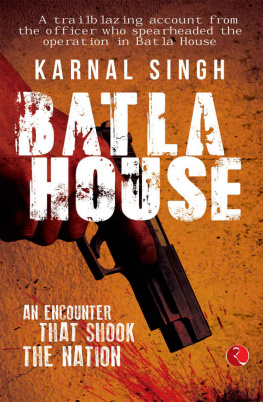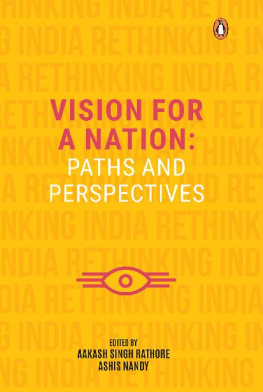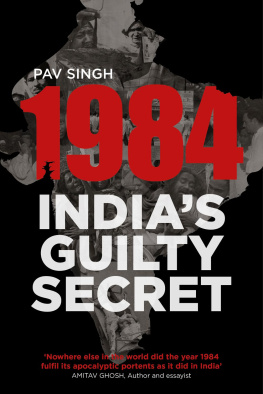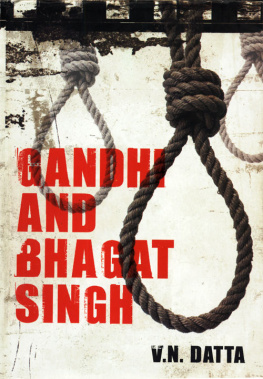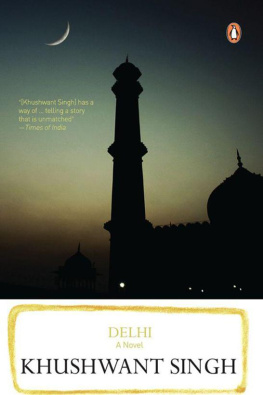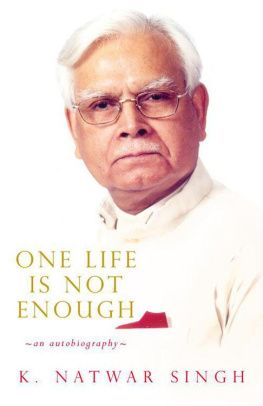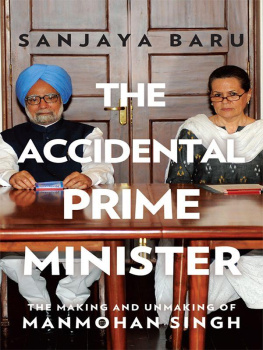

Karnal Singh, a 1984-batch IPS officer and an engineer from the Delhi College of Engineering (DCE) and the Indian Institute of Technology (IIT) Kanpur, has over 34 years of experience in the investigation of corruption, terrorism, money laundering and criminal cases. In Delhi Police Special Cell, he spearheaded the investigation of the 2008 Delhi blast cases, which led to the Batla House encounter. He is a recipient of Presidents Police Medal for Distinguished Service and Police Medal for Meritorious Service.

Published by
Rupa Publications India Pvt. Ltd 2020
7/16, Ansari Road, Daryaganj New Delhi 110002
Copyright Karnal Singh 2020
All rights reserved.
The views and opinions expressed in this book are the authors own and the facts are as reported by him which have been verified to the extent possible, and the publishers are not in any way liable for the same.
No part of this publication may be reproduced, transmitted, or stored in a retrieval system, in any form or by any means, electronic, mechanical, photocopying, recording or otherwise, without the prior permission of the publisher.
ISBN: 978-93-90260-37-9
First impression 2020
The moral right of the author has been asserted.
This book is sold subject to the condition that it shall not, by way of trade or otherwise, be lent, resold, hired out, or otherwise circulated, without the publishers prior consent, in any form of binding or cover other than that in which it is published.
In honour ofMohan Chand Sharmaand the countless unsung heroes who have lost their livesfighting against terrorism


CONTENTS
List of pages
PROLOGUE
19 September 2008
I was at the Delhi Police Special Cell office in Lodhi Colony. I looked at my watch. It was 10.45 a.m. Two teams were on their way to Batla House. Delhi had witnessed a devastating terrorist attack six days ago, on 13 September, by a terror outfit called the Indian Mujahideen (IM). The explosions in heavily crowded public places had claimed 22 lives and injured 131 people.
Special Cell teams had been working night and day since then to gather intelligence and trace the perpetrators. Our investigation and surveillance leads had raised suspicion on a particular resident of Flat no. 108, L-18, Batla House. We led our teams there that day to search and investigate further.
At around 11.00 a.m., my phone rang. It was a call from Inspector Mohan Chand Sharma, who was leading the first team. Sir, we are going in, he said.
All the best! I replied and kept the phone down.
The next few minutes dragged on as I anxiously waited to know if we had found the suspected terrorists. Meanwhile, shots being fired were heard in the Batla House area.
Around 10 minutes after Mohans call, my phone rang again. Assistant Commissioner of Police (ACP) Sanjeev Kumar Yadav was on the line. He spoke in a tearful voice. Sir, Mohan and Head Constable (HC) Balwant Singh have been shot and have sustained bullet injuries.
I was shocked. What happened? Where are they? I asked.
Sanjeev replied that they were being shifted to the hospital. He mentioned that terrorists were also injured and were inside the house.
I replied on the call, Sanjeev, we have to catch them alive they are the key I am on my way. I am also requisitioning additional force.
Yes, sir, Sanjeev said.
More shots were heard in Batla House.
1
EYE FOR AN EYE: THE DUST WILL NEVER SETTLE DOWN
13 September 2008
(Six days before the Batla House shoot-out)
It was a quiet Saturday at home. I was engrossed in reading a book on science fiction. The television was playing in the background.
Chai chahiye? (Do you want some tea?) my wife, Renuka, asked me. I replied with a distracted hmm. She went into the kitchen and I resumed reading.
A few minutes later, she came back with tea. My son, Archit, who was 13 years old at that time, came running to me with a notebook and a pencil in his hand. Papa, can you help me with this math problem? he said, pointing to his notebook. I kept my book aside and started questioning him on the basics of math to gauge how much he already understood and the areas where he needed my help. I didnt get to spend enough time with my family on weekdays, so I cherished whatever little time I got with them over the weekends. My daughters, Shruti and Kritika, were already in college and we spoke more over the phone than in person. I patted my sons head as he sat on the floor and attempted to solve the problems.
Just then, my phone started ringing. Who can it be on a Saturday evening? I wondered. I picked up my phone to see the name of a journalist flashing on the screen.
Hi, Vishal (name changed), I answered the call.
Sir, has there been a blast in Karol Bagh?
Just then, my landline started ringing too. I was also getting another call on my mobile. It was from the Police Control Room (PCR).
Let me call you back, Vishal. I have a call waiting. I disconnected the call, fearing the worst.
I took the call from the PCR. There was indeed an explosion in Karol Bagh a few minutes ago. I told the PCR that I was leaving for the blast site. Have the Special Cell teams been informed?
Yes, sir, we are alerting all senior officers and field units as per protocol.
My wife was getting a bit anxious. Kya hua? Sab theek hai? (What happened? Is everything okay?)
There is a report of a bomb explosion in Karol Bagh. I am going there now, I replied.
I called out to the driver to get ready to leave. I quickly put on a shirt as I answered a barrage of calls.
Is anyone hurt? my wife asked me, worried.
I dont know yet. I will speak to you later, I replied as I got into the car.
Oh, where is Shruti? I asked. Shruti, our eldest daughter, was in the third year of fashion designing at the National Institute of Fashion Technology (NIFT), Delhi.
She is working on some project with her friends. After that, they will go to Lajpat Nagar or Nehru Place, I am not exactly sure, to buy some fabric, my wife replied.
Call and check on her, and ask her to come home immediately.
Okay, be safe, my wife added and waved me goodbye.
On my way, I spoke to Shri Yudhvir Singh Dadwal, commissioner of police (CP), over the phone, to discuss the course of action. He told me that he had already declared a Red Alert in the whole of Delhi.
I passed on the message to the police stations through the PCR instructing them to immediately deploy manpower in the hospitals where the injured were being taken. The police was asked to look for any vehicle that was left unattended in the vicinity of the hospitals. I coordinated with the Special Cell officers to discuss which team members were to be engaged and assign tasks to them accordingly.
I had joined as the head of the Delhi Police Special Cell first as Additional Commissioner in January 2004 and continued after my promotion as Joint CP in June 2004. In recent years, the Special Cell had cracked many important cases of terrorism including the bomb explosions in Liberty and Satyam Cinema, and the Diwali blasts of 2005. The department is credited with arresting more than 200 dreaded gangsters and 140 terrorists, neutralizing 20 terrorists from various terror modules, preventing several attacks and neutralizing 56 criminals during my stint in the Special Cell.
Next page
